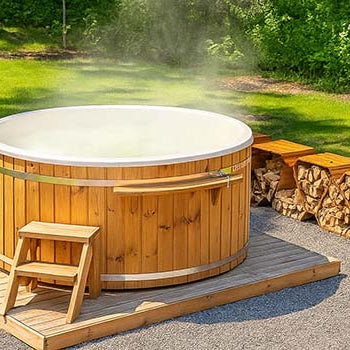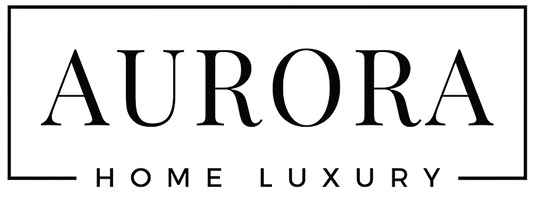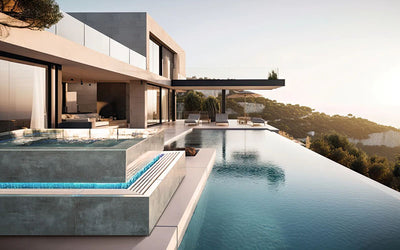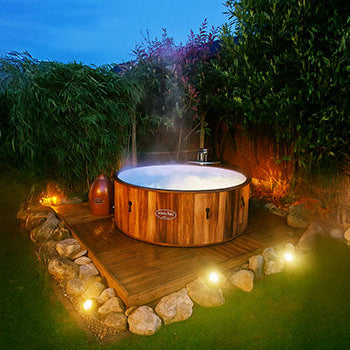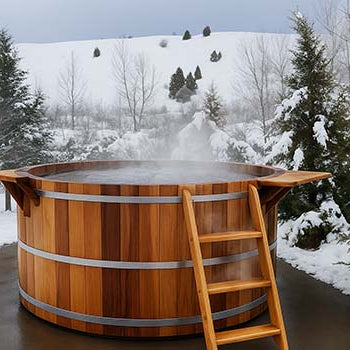Do hot tubs use a lot of power? Short answer: sometimes, but not always. It all depends on how they’re built, how often you soak, and how well you keep the heat in. Acrylic hot tubs are great at holding warmth, rotomoulded tubs are light on the wallet but heavier on bills, while wooden tubs? Gorgeous to look at, but not the most energy-savvy. If you’re curious about running costs or just want to trim your next bill, this guide has you covered. Let’s break down what’s draining your electricity and what you can do about it.

Identifying the Power Consumers in Your Hot Tub
The Heater: The Main Driver of Electricity Use
This is your hot tub’s biggest energy guzzler. The heater’s job is to keep your water warm, even when it's freezing outside. Most run at around 2 to 3 kW, switching on and off to maintain your set temperature.
If your tub loses heat quickly, that heater will run far more often. Poor insulation = higher bills.
Pumps: Powering Circulation and Jets
Your tub’s pumps keep water moving and jets bubbling. The smaller circulation pump runs quietly for hours to filter your water, using modest energy. The jet pump, however, packs a punch and uses more power when switched on.
A quick soak with jets? Fine. Long, bubbly sessions every night? That adds up fast.
Lighting, Controls, and Other Electrical Components
Things like LED lights, Bluetooth speakers, and digital panels all use power, but very little compared to your heater or pumps.
Unless you’re running a full-on light show every evening, these extras won’t break the bank.
Key Factors Influencing Power Consumption
Insulation Quality: Why It's Paramount for Efficiency
Think of insulation as your hot tub’s winter coat. Good insulation keeps the heat in and the electricity bill down. Acrylic tubs often come with multi-layer insulation, while cheaper tubs may lack this entirely.
If heat escapes quickly, your heater’s working overtime.
Water Temperature Settings vs. UK Air Temperatures
It’s 2°C outside, but your tub’s set at 38°C? That’s a huge temperature gap. The colder the air, the more energy it takes to keep things steamy.
Dropping the temp to 36°C can still feel great and save you cash.
Hot Tub Size and Water Volume to be Heated
A bigger tub means more water to heat and more water to keep warm. A two-seater tub takes far less power than a party-size seven-seater.
Wooden tubs, which tend to be large and less insulated, can be the priciest to run.
How Often and How Long You Use the Jets
Jets don’t just feel good, they feed off electricity. A quick 15-minute soak with jets won’t cost much, but using them daily for long periods adds up.
If you're soaking solo, do you need full power jets?
The Importance of a Good Quality Thermal Cover
Without a solid thermal cover, your heat floats away. Covers trap warmth and cut down the heater’s workload.
Worn-out, waterlogged covers? Bin them and upgrade. Your bills will thank you.
Impact of Location and Wind Exposure
Wind whisks heat away from your tub’s surface and shell. If your spa is out in the open, you’re losing heat fast.
Position it near a wall, fence, or in a pergola to create a warm bubble of protection.
Component Age and Efficiency
Old heaters and pumps aren't just slow, they’re power-hungry. Newer models come with better tech and smarter energy use.
If your hot tub’s a decade old, a few upgrades can lower your electricity bill without replacing the whole thing.

Estimating Hot Tub Electricity Usage and Costs in the UK
Understanding Power Ratings (kW)
Each part of your hot tub has a power rating in kilowatts. Heaters are usually 2 to 3 kW, jet pumps range from 1.5 to 2.5 kW, and circulation pumps sit around 0.5 kW.
Knowing these numbers helps you plan your energy use.
Calculating Kilowatt-Hour (kWh) Consumption Estimates
Electricity is charged in kilowatt-hours (kWh). If a 3 kW heater runs for one hour, it uses 3 kWh. Multiply that by your tariff, around 28p per kWh in the UK, and you’ll know the cost.
Use a smart meter or energy calculator to track it more closely.
Estimating Daily, Monthly, and Annual Costs (Based on UK Energy Prices)
A well-insulated tub in summer might cost £1–£2 per day. In winter? More like £2–£4, depending on your setup.
That adds up to £30–£120 a month, or £400–£900 a year, assuming moderate use and decent insulation.
Consumption Differences: Inflatable vs. Well-Insulated Models
Inflatable hot tubs are cheap to buy, but expensive to run. With little insulation, they struggle to hold heat.
Acrylic tubs may cost more upfront, but are designed to retain heat better, saving you more long term. Wooden tubs? Great for rustic vibes, but often the most power-hungry of the bunch.
Practical Ways to Reduce Your Hot Tub's Electricity Bill
Choose a Hot Tub with Superior Insulation
Insulation is everything. The better it is, the less work your heater has to do. Look for tubs with full-foam or multi-layer thermal insulation.
You’ll feel the difference in warmth and your bill.
Always Use a High-Quality, Well-Fitting Cover
Don’t let heat escape overnight. A tight-fitting thermal cover is one of the easiest energy-saving hacks.
Replace covers when they get soggy, saggy, or worn out.
Optimise Your Temperature Settings Strategically
Lower temps during weekdays or between soaks can save a surprising amount. You don’t need it at full blast all the time.
Try dropping the setting to 36°C, still hot, just cheaper.
Consider Investing in an Air Source Heat Pump
Air source heat pumps pull warmth from the air and use less energy to heat your tub. It’s an upfront cost, but you’ll see savings if you use your hot tub regularly.
They’re quiet, efficient, and work even in cold climates.
Add a Floating Thermal Blanket Under the Main Cover
Think of it as a cosy layer that sits right on the water. A thermal blanket reduces surface heat loss and boosts insulation.
It’s affordable, easy to use, and makes a real difference.
Shelter Your Hot Tub from Wind
Even light breezes can steal heat. Wind barriers like fences, shrubs, or screens create a warmer microclimate around your spa.
It’s a simple fix that can lower energy use every day.
Regular Maintenance for Peak Efficiency
Clean filters, working pumps, and a responsive heater all contribute to smoother, more efficient performance.
Neglect maintenance, and your tub starts costing more.
Putting Power Usage into Context
Comparing Hot Tub Energy Use to Other Household Appliances
So, how does your spa stack up? A hot tub uses about as much energy as a dishwasher running daily, or a tumble dryer used three times a week.
Not cheap, but not outrageous either, especially if you follow a few energy-saving tricks.

Conclusion: Understanding and Managing Hot Tub Power Consumption
So, do hot tubs use a lot of power? They can, but they don’t have to.
The secret lies in the setup: great insulation, smart heating, and a few tweaks to your routine. Acrylic hot tubs are usually the most efficient, rotomoulded types sit in the middle, and wooden tubs need the most TLC to stay warm.
With a bit of strategy, your spa can be a cosy retreat—not a power-hungry monster. Choose the right model, keep it well covered, and keep your energy use in check. That way, every soak feels like a win for both comfort and your wallet.
